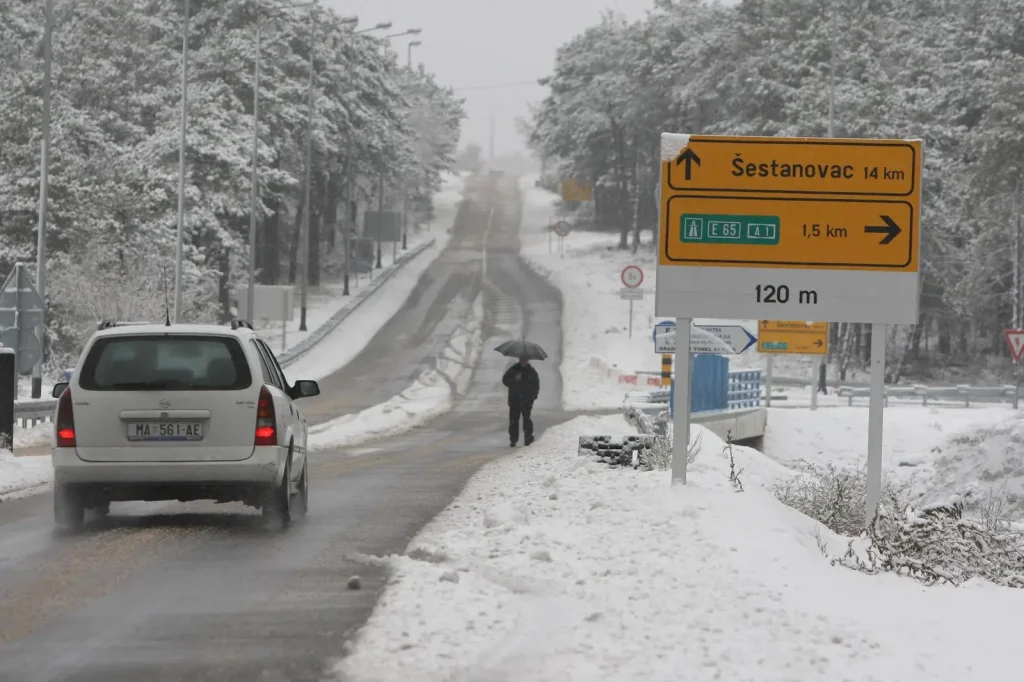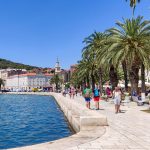People always laugh at me when I go on about how good Croatian roads are, but they really, really are. Compared to British roads anyway. The further north you get in the UK, the more track-like they become. The amount of potholes in the roads where I come from would soon dislodge any kidney stone, they might take a filling or two away, as well.
To say that Croatia is for the most part a very rugged, mountainous land, with the exception of the Eastern part of the country, the roads are absolutely outstanding. The new motorways built not so long ago make everything easier and the country is extremely well connected, but what about actually driving on them?
You drive in Croatia on the right and all overtaking is done on the left. Seat-belts are of course compulsory, and the use of mobile phones or any other device while driving is banned. The police are very much on the ball with this type of thing, more so than in other countries. This is especially the case during the busy summer months, when there is more traffic in general and unfortunately – more accidents also.
The motorway speed limit is 130 km/h, 90 km/h on national roads, and 50 km/h in urban areas.
Winter tyres and headlights during the day are requirements during the winter months, from around November the 15th to April the 15th.
Croatia’s motorways are relatively new, fantastically built and very, very expensive. They will likely remain looking brand new for a while to come yet, as for the most part, the newer sections are rather empty, apart from during the peak tourist season when they’re packed with cars and motorhomes with foreign licence plates all heading down to the coast. Because of the sudden increase in traffic, traffic jams, long queues at the country’s various land border crossings and bottlenecks are frequent occurrences.
During these times of heightened tension, sweltering heat and the endless ‘are we there yet’ on repeat from the back seat, it makes sense to consider taking the old road from Zagreb down to Split, which is usually fairly empty (unless everyone has had the exact same idea, of course), but also stunningly beautiful. You’ll see parts of Croatia’s absolutely jaw dropping coastline that you otherwise would completely bypass, and with the amount of cars on the road during summer, there’s no guarantee you’d have reached your final destination much faster anyway.
Toll prices are expensive and can be paid for by cash (kuna) or by credit/debit card. Non-residents have always been able to pay for this service in euros, which of course will also be the norm as of the 1st of January, 2023, when Croatia becomes the newest Eurozone member and adopts the single currency. Prices are reduced by 10% in winter, and to work out the costs of your road trip, there is an interactive motorway map and toll calculator available if you visit www.hac.hr/en/interactive-map.
If you live in Croatia and you plan to become a regular motorway user, you can apply for the ETC (Electronic Toll Collection) scheme, which has the dual benefit of offering a discount on toll prices, as well as a separate toll booth (the special booth will be marked with the letters ENC). This is usually less busy. The downside is that the service is a prepaid one, but if you’re a regular, you’ll be glad of it.
Car rentals
As one would expect for a major tourist destination, Croatia has a wide selection of car rental options available, from large, well known companies to smaller agencies which might be more flexible in what they offer should you need that. These vehicles can be rented from airports and delivered to hotels, and the concept of one-way rental is commonplace all over the country. Some of the more enterprising island-based car rental companies, for instance, offer one day rental cars with collection taking place at the ferry terminal itself. This allows tourists to come and sample a given island in one single day without the added expense and stress of two ferry tickets. I’ll talk more about this in the ‘Getting Around’ chapter.
Up to date traffic information in English
You can easily find the latest road information in English language on the HAK website (as well as current information on ferries, trains, and borders). The website you’ll need is the following: www.hak.hr. Additionally, the Croatian Motorways website has a section with the very latest updates. Additionally, you can download the HAK traffic app, which gives you all the latest information in English, as well as help with roadside assistance should you need it, which hopefully you won’t. There is also a comprehensive database of 15,000 places of interest, spanning everything from national parks to healthcare facilities. We hope you’ll be making more trips to the former than the latter.
Don’t consume any alcohol if you’re getting behind the wheel in Croatia
Croatian law has a zero tolerance policy for drivers under 25 which means that their blood alcohol level (BAC) limit is a very strict, very clear 0%. The BAC limit for drivers over 25 years old isn’t much different, at just 0.05% (or 0.5 g/l). It is never worth it to drink and drive, wherever you are, but the rules here are very strict and the police are very active during the summer months. If you’re going to drive in Croatia, just put the Karlovacko down unless you want to end up with a headache far stronger than beer could ever give you.
Webcams
HAK has a good network of webcams located all over the country for motorists looking to keep an eye on the latest situations on various roads. These include several locations on each or Croatia’s motorways, ferry terminals, important bridges, national roads, and border crossings.
Driving and ferry crossings
A drive in Croatia is never quite complete without a trip to some of the country’s stunning islands, which is a very popular activity, especially in the summer. While the car ferry service generally works well, it won’t hurt to keep a few things firmly in mind before you embark: Firstly, buying a car ticket doesn’t guarantee you entry on the ferry. It seems a bit illogical I know, but boarding a ferry with a car is carried out on a strictly first come, first served basis, and if you want to ensure you make the ferry with your car, you should get there with plenty (and I mean plenty) of time to spare during the peak tourist season when many ferries are packed solid. If the ferries cannot handle the sheer amount of human (and car) traffic, there are often additional ferries put into function on various busy lines in order to reduce the waiting times. Don’t count on this, however, just get there with some time to kill. If you’re interested in ferries, catamarans and how they work, I’ll get into that in the ‘Getting Around’ chapter as well.
Parking
I’m sure that Diocletian could never have imagined that in a few centuries time, people would be lining the narrow, ancient streets of the city in which he chose to build his remarkable retirement palace (Split), with Ford Fiestas that have been reversed into and scratched by scooters a few dozen times. Parking in Croatia is, to put it bluntly, a complete and utter pain in the backside, especially in the bigger cities. You might get lucky now and again, and outside of the summer season, you do get lucky more frequently, but technology has had to step in and come to the rescue of many a frustrated driver. One of the best examples of this is the SMS parking service which is now available in most bigger Croatian cities.
Once you’ve parked, you just need to dial the number on the parking info sign which will be easily located and seen where you’ve parked, enter your licence plate, and your payment will be added to your phone bill. Innovative!
Do be aware, however, that street parking in the City of Zagreb is limited to 2 or 3 hours in the very centre. So, if you do manage to find a spot and think you are there for the day, think again. There are various garages and other parking options where you can freely leave your car, however. They can come at a bit more of a cost, but the peace of mind is worth it.
Electric vehicles
Croatia is the birthplace of the genius Nikola Tesla, who was born in Smiljan (which was then part of the Austro-Hungarian Empire) in Western Lika on the 10th of July, 1856. The name ‘Tesla’ is now synonymous with the electric cars which we’re seeing more and more frequently on the roads, in spite of their expense.
A modern-day genius from Livno, Bosnia and Herzegovina, Mate Rimac, has been keeping Nikola’s desires alive in this country. This doggedly determined Croatian entrepreneur and passionate lover of cars has been continuing the Croatian mantle of electric innovation, and doing so beyond successfully. His company Rimac Automobili produces the fastest electric supercars in the entire world, and it is doing so in a country with no other automotive industry to even speak of. Sometimes described as Europe’s very own Elon Musk, Rimac is the protagonist of what is by far modern day Croatia’s most successful entrepreneurial story.
Thanks to both Nikola and Mate, the electric vehicle revolution is being drip fed into Croatia much like it is everywhere else, and Tesla charging stations are on the increase. There are now hundreds of electric vehicle charging stations across the entire country, and their numbers will just keep on increasing as electric cars grow in popularity.
I’m a resident of Croatia with a foreign driving licence, do I need to exchange it?
Short answer, yes, but not everyone does.
If your driving licence has been issued by another EEA member state
An application for the issuance of a Croatian driving licence needs to be submitted at (you guessed it) an administrative police station which deals with the issuance of driving licences. Once you’re there the clerk will fill in the application form for the issuance of a Croatian driving licence and you as the applicant will need to confirm the accuracy of the data the clerk has entered by signing the application form.
You’ll need to provide the following:
Proof of your identity (a passport, government issued ID or your Croatian residence permit)
Your driving licence issued by another EEA member state
A 35×45 mm photograph of you
Proof of you having paid an administrative fee for the procedure. This payment can be made using a paper payment slip or via internet banking. The payment should be made to the Croatian state budget’s bank account, the details of which are as follows:
IBAN: HR1210010051863000160, model: HR64, reference number: 5002-713-OIB, purpose of payment: ‘državne upravne pristojbe’
Proof of you having paid for either a standard procedure, an accelerated procedure, or an urgent procedure for the issuance of a Croatian driving licence. Choose a standard procedure if you’re in no rush to get the document, and the latter two if you are, obviously. You can pay with a paper payment slip which can be collected at the administrative police station, with a general payment slip or via internet banking.
You’ll need to pay into the Croatian state budget’s bank account, the details of which are as follows:
IBAN: HR1210010051863000160, model: HR65, reference number: 7005-477-OIB
If the date of first issuance for each category of vehicle the licence allows you to drive isn’t specified on the driving licence issued in another EEA member state, you’ll also need to enclose a certificate from the competent EEA member state authority confirming the date of first issuance for each category.
If your driving licence has been issued by a third country (a non-EEA member state)
The process and where you need to go (to an administrative police station which deals with the issuing of driving licences) is the same as is detailed above, but the documents you’ll need varies slightly. You’ll need the following:
Proof of your identity
Your foreign driving licence issued in a non-EEA member state
A translation of that foreign driving licence if the categories for which the licence can be exchanged are not evident, or if it isn’t evident whether the foreignlicence is still valid, or if it expired more than six months ago
A medical certificate confirming you can indeed drive a vehicle. This certificate can’t be older than six months
A 35×35 mm photo of you
Proof of you having paid an administrative fee for the procedure in the amount either with a payment slip or using internet banking. The payment should be made to the Croatian state budget’s bank account, the details of which are the following:
IBAN: HR1210010051863000160, model: HR64, reference number: 5002-713-OIB, purpose of payment: ‘državne upravne pristojbe’
Proof of you having paid for a standard procedure, an accelerated procedure or an urgent procedure. The payment details are as follows:
IBAN: HR1210010051863000160, model: HR65, reference number: 7005-477-OIB.
If the date of first issuance for each vehicle category is not specified on your licence, you also need to enclose a certificate issued by the competent foreign authority confirming the date of first issuance for each category.
Things to note
There is no need to enclose a photo of you if, over the last five years, you’ve been issued with a biometric passport, an e-ID card, or an e-driving licence issued after September the 4th, 2017, for the issuance of which a photo was enclosed, provided that your appearance hasn’t changed significantly.
Just like anywhere else, Croatia has some excellent drivers and some absolutely terrible ones. Sometimes, the driving leaves a lot to be desired in more rural areas, so do take care and always abide by the national rules if you want to drive in Croatia, whether you be in a selo (village) or a grad (town or city). As I mentioned before, the police tend to be much more on the ball when it comes to traffic offences here, especially during summer.
For more on How to Croatia, which we’ll write each week, make sure to keep up with our dedicated lifestyle section.












